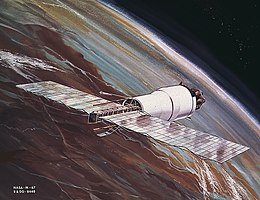Pegasus 1

A Pegasus satellite in orbit
|
|
| Mission type | Micrometeoroid detection |
|---|---|
| Operator | NASA |
| COSPAR ID | 1965-009A |
| SATCAT no. | 001085 |
| Mission duration | 3 years 6 months 13 days |
| Spacecraft properties | |
| Spacecraft type | Pegasus |
| Manufacturer | Fairchild Hiller |
| Launch mass | 10,297 kilograms (22,701 lb) |
| Payload mass | 1,450 kilograms (3,200 lb) |
| Start of mission | |
| Launch date | 16 February 1965 |
| Rocket | Saturn I SA-9 |
| Launch site | Cape Canaveral LC-37B |
| End of mission | |
| Disposal | Decommissioned |
| Deactivated | 29 August 1968 |
| Decay date | 17 September 1978 |
| Orbital parameters | |
| Reference system | Geocentric |
| Regime | Low Earth orbit |
| Perigee | 500 kilometers (270 nmi) |
| Apogee | 731 kilometers (395 nmi) |
| Inclination | 31.7 degrees |
| Period | 97.00 minutes |
| Epoch | 18 March 1965 |
|
Apollo micrometeoroid investigation
|
|
Pegasus 1 or I, known before launch as Pegasus A, was an American satellite which was launched in 1965 to study micrometeoroid impacts in low Earth orbit. It was the first of three Pegasus satellites to be launched. The Pegasus spacecraft were manufactured by Fairchild Hiller, and operated by NASA.
Pegasus 1 was a Pegasus satellite, consisting of 1,450 kilograms (3,200 lb) of instruments, attached to the S-IV upper stage of the carrier rocket which had placed it into orbit. It had a total mass of 10,297 kilograms (22,701 lb), and was equipped with two sets of micrometeoroid detection panels, and a radio for tracking and returning data. The panels were 29 meters (95 ft) long, and equipped with 116 individual detectors.
Pegasus 1 was launched atop a Saturn I rocket, serial number SA-9, flying from Launch Complex 37B at the Cape Kennedy Air Force Station. The launch occurred at 14:37:03 UTC on 16 February 1965. Following launch, Pegasus 1 was given the COSPAR designation 1965-009A, while NORAD assigned it the Satellite Catalog Number 01085.
Pegasus 1 was a secondary payload of Apollo program mission AS-103, which also carried a boilerplate Apollo spacecraft BP-16. The Apollo boilerplate acted as a payload fairing for the Pegasus spacecraft, which was stored inside what would have been the Service Module of a functional spacecraft. Upon reaching orbit, the boilerplate Command and Service modules were jettisoned.
...
Wikipedia
